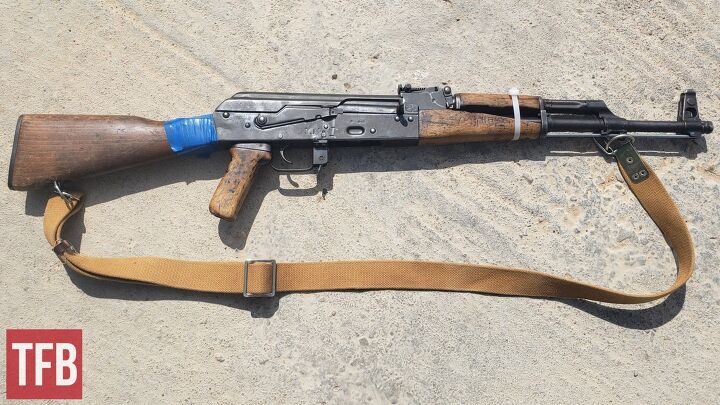It is hard to find a product made in North Korea (NK) that is used all around the world. But there is one thing from NK you can easily find in Africa, the Middle East, and even South America – North Korean AKs.
I first came across those guns in Afghanistan and later on, found an entire collection of North Korean guns in various provinces of Somalia. And while my experience with those guns is limited, I was lucky to come across some interesting info about those rare AKs.
AK History @ TFB:
- AKs from Finland. Part 4: RK 95, The Last of the Clan
- Egyptian AKs (Misr, Maadi). Part 2: Quality, Problems and Modernization Projects
- East Germany AKs – The Best In The World? Part 3: Less Known Variants
- Hungarian AKs (Part 4): From Wonderfully Weird to Plain and Reliable
History of North Korean AKs
After the Korean War of 1950-1953, the Northern part of the country aligned with the Soviet Union and China. At that time, the Northern part of Korea had a more developed industry compared to the Southern part. It only took a few decades of communist paradise to turn this around in the most dramatic way.
In 1949, North Korea started production of Type 49, their version of the Soviet submachinegun PPsh-41. However, in a few years, just like other socialist states, the country received a transfer of technology (ToT) for AK rifles. It was not first in line – while Eastern European countries started this process as early as 1955, North Korea adopted its first AK in 1958 and called it Type 58.

North Korean Type 58 the author photographed in Somalia
The gun is still used to this day by some of the North Korean army units. Some say, only 50,000 of those AKs were made, some claim 800,000, but I think anybody who tries to estimate the number is just kidding himself. After all, we are talking about the North Korean defense industry, they are not exactly known for their transparency and openness.
Some of those Type 55s were sold to the Vietcong during the Vietnam War and brought to the USA as trophies. Now, a properly registered Type 58 sells on US auctions for anywhere between $42,000 to $63,000. Not bad for a 50-year-old service rifle. So, naturally, Type 58 is pretty hard to come by.
That is why I was quite surprised when I found one in a dusty container on a base in Mogadishu, Somalia. I left my phone at a different base that day, and obviously, I was pretty angry at myself. You don’t come across rare North Korean AKs every day. Thankfully, one of the African guards courteously offered me his phone so I could take some pictures for this article.

North Korean Type 58 the author photographed in Somalia
Type 58 is a direct copy of the Soviet Type 3. It was produced by both North Korean weapons factories. Those factories allegedly don’t have names, just numbers, 61 and 65, and both are located in Chongjin, a big industrial city famous for steel production.
Identifying a Type 58 is easy – there is a “five-point star in the circle” marking on the left side of the receiver. Other than that, however, the fact that North Korean AKs were easily identifiable wasn’t acceptable to the DPRK government.
Sanctions and trade embargoes were always a part of life for North Korea, so the next generation of North Korean AKs had the most incredibly deceiving and complicated set of markings, meant to throw off anybody who would try to determine the origins of the weapon.

Markings on Type 68 manufactured for domestic use
In 1968, North Korea started production of Type 68, the AKM variant. For this gun, there were at least four different sets of markings. Guns for the Korean People’s Army retained markings of Type 58: Korean characters for the selector markings on the receiver and rear sight and the same “five-point star in the circle” along with the number “68” which signifies that it is called Type 68.
Some North Korean AKs intended for domestic use ended up in other countries, but the majority of DPRK-made guns found internationally actually have special “sanitized” markings.
The export versions had no logo, and selector markings are similar to Hungarian: infinity sign for full auto and Roman numeral “I” for semi-auto mode. Roman numerals were also used on the rear sight. So, on an export North Korean AK, nothing points to the country that made it.

For some reason, selector markings on Type 68 are always stamped in the wrong location
Other countries had similar arrangements for domestic and export guns, but North Korea went two steps further. They started manufacturing guns with S-A-R selector markings, identical to those on Romanian and some Egyptian AKs.
But that is not all. Some guns sold to Arabic-speaking countries, particularly Syria, had markings in Arabic, further complicating the identification process. Conflict Armament Research (CAR) wrote a really good guide, documenting their findings of North Korean AKs in the Middle East.

Type 68 the author photographed in Puntland, Somalia
There is, however, a foolproof way of identifying North Korean AKs. You just need to look at the actual features, not the markings.
We will talk about it in part 2 of this article, as well as explore the countries that bought North Korean AKs and even managed to get a transfer of technology.
 Your Privacy Choices
Your Privacy Choices